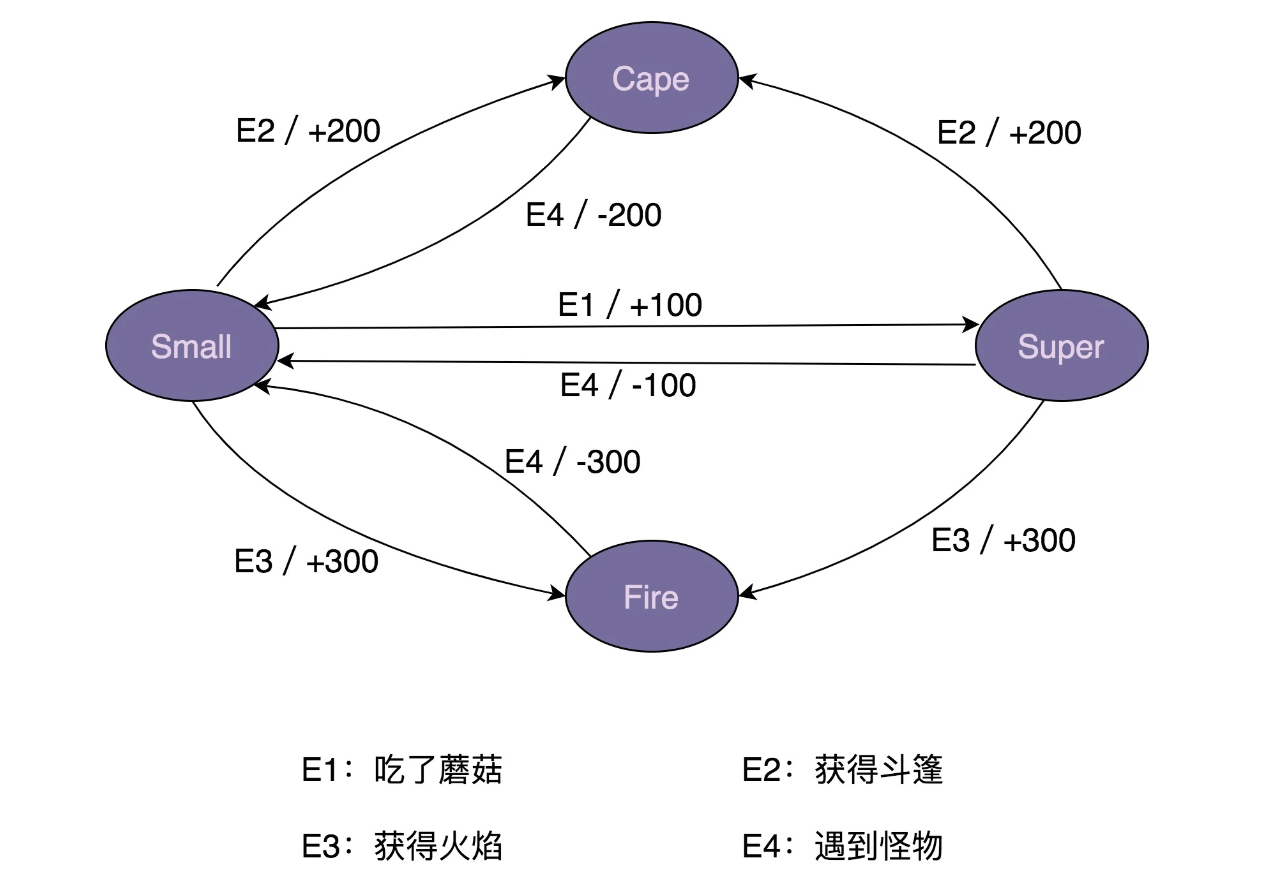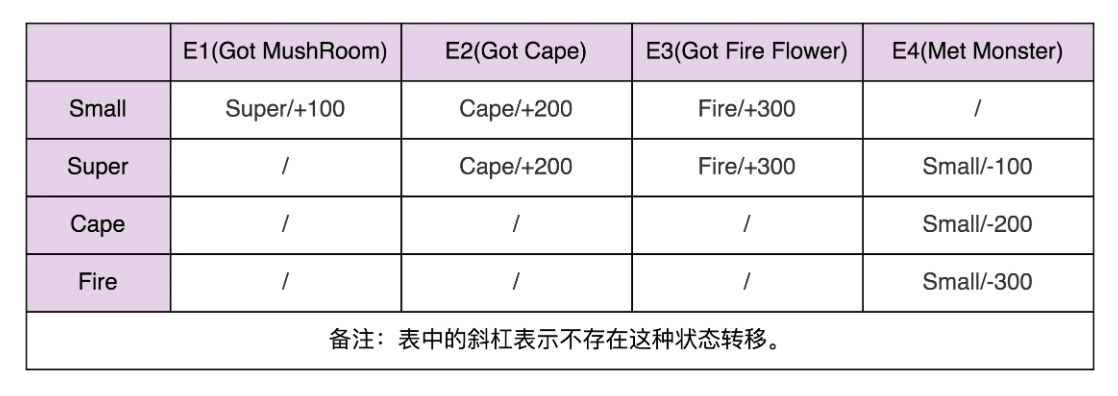状态模式一般用来实现状态机,而状态机常用在游戏、工作流引擎等系统开发中。不过,状态机的实现方式有多种,除了状态模式,比较常用的还有分支逻辑法和查表法。
什么是有限状态机? 有限状态机,英文翻译是 Finite State Machine,缩写为 FSM,简称为状态机。状态机有 3 个组成部分:状态(State)、事件(Event)、动作(Action)。其中,事件也称为转移条件(Transition Condition)。事件触发状态的转移及动作的执行。不过,动作不是必须的,也可能只转移状态,不执行任何动作。
在“超级马里奥”游戏中,马里奥可以变身为多种形态,比如小马里奥(Small Mario)、超级马里奥(Super Mario)、火焰马里奥(Fire Mario)、斗篷马里奥(Cape Mario)等等。在不同的游戏情节下,各个形态会互相转化,并相应的增减积分。比如,初始形态是小马里奥,吃了蘑菇之后就会变成超级马里奥,并且增加 100 积分。
实际上,马里奥形态的转变就是一个状态机。其中,马里奥的不同形态就是状态机中的“状态”,游戏情节(比如吃了蘑菇)就是状态机中的“事件”,加减积分就是状态机中的“动作”。比如,吃蘑菇这个事件,会触发状态的转移:从小马里奥转移到超级马里奥,以及触发动作的执行(增加 100 积分)。状态转移如下图所示:
1 2 3 4 5 6 7 8 9 10 11 12 13 14 15 16 17 18 19 20 21 22 23 24 25 26 27 28 29 30 31 32 33 34 35 36 37 38 39 40 41 42 43 44 45 46 47 48 49 50 51 52 53 54 55 56 57 58 59 60 61 public enum State { SMALL(0 ), SUPER(1 ), FIRE(2 ), CAPE(3 ); private int value; private State (int value) { this .value = value; } public int getValue () { return this .value; } } public class MarioStateMachine { private int score; private State currentState; public MarioStateMachine () { this .score = 0 ; this .currentState = State.SMALL; } public void obtainMushRoom () { } public void obtainCape () { } public void obtainFireFlower () { } public void meetMonster () { } public int getScore () { return this .score; } public State getCurrentState () { return this .currentState; } } public class ApplicationDemo { public static void main (String[] args) { MarioStateMachine mario = new MarioStateMachine (); mario.obtainMushRoom(); int score = mario.getScore(); State state = mario.getCurrentState(); System.out.println("mario score: " + score + "; state: " + state); } }
状态机实现方式一:分支逻辑法 对于如何实现状态机,最简单直接的实现方式是,参照状态转移图,将每一个状态转移,原模原样地直译成代码。这样编写的代码会包含大量的 if-else 或 switch-case 分支判断逻辑,甚至是嵌套的分支判断逻辑。按照这个实现思路,补全之后的代码如下所示:
1 2 3 4 5 6 7 8 9 10 11 12 13 14 15 16 17 18 19 20 21 22 23 24 25 26 27 28 29 30 31 32 33 34 35 36 37 38 39 40 41 42 43 44 45 46 47 48 49 50 51 52 53 54 55 56 57 58 59 public class MarioStateMachine { private int score; private State currentState; public MarioStateMachine () { this .score = 0 ; this .currentState = State.SMALL; } public void obtainMushRoom () { if (currentState.equals(State.SMALL)) { this .currentState = State.SUPER; this .score += 100 ; } } public void obtainCape () { if (currentState.equals(State.SMALL) || currentState.equals(State.SUPER) ) { this .currentState = State.CAPE; this .score += 200 ; } } public void obtainFireFlower () { if (currentState.equals(State.SMALL) || currentState.equals(State.SUPER) ) { this .currentState = State.FIRE; this .score += 300 ; } } public void meetMonster () { if (currentState.equals(State.SUPER)) { this .currentState = State.SMALL; this .score -= 100 ; return ; } if (currentState.equals(State.CAPE)) { this .currentState = State.SMALL; this .score -= 200 ; return ; } if (currentState.equals(State.FIRE)) { this .currentState = State.SMALL; this .score -= 300 ; return ; } } public int getScore () { return this .score; } public State getCurrentState () { return this .currentState; } }
对于简单的状态机来说,分支逻辑这种实现方式是可以接受的。但是,对于复杂的状态机来说,这种实现方式极易漏写或者错写某个状态转移。除此之外,代码中充斥着大量的 if-else 或者 switch-case 分支判断逻辑,可读性和可维护性都很差。如果哪天修改了状态机中的某个状态转移,我们要在冗长的分支逻辑中找到对应的代码进行修改,很容易改错,引入 bug。
状态机实现方式二:查表法 实际上,上面这种实现方法有点类似 hard code,对于复杂的状态机来说不适用,而状态机的第二种实现方式查表法,就更加合适了。接下来,我们就一块儿来看下,如何利用查表法来补全骨架代码。实际上,除了用状态转移图来表示之外,状态机还可以用二维表来表示,如下所示。在这个二维表中,第一维表示当前状态,第二维表示事件,值表示当前状态经过事件之后,转移到的新状态及其执行的动作。
相对于分支逻辑的实现方式,查表法的代码实现更加清晰,可读性和可维护性更好。当修改状态机时,我们只需要修改 transitionTable 和 actionTable 两个二维数组即可。实际上,如果我们把这两个二维数组存储在配置文件中,当需要修改状态机时,我们甚至可以不修改任何代码,只需要修改配置文件就可以了。具体的代码如下所示:
1 2 3 4 5 6 7 8 9 10 11 12 13 14 15 16 17 18 19 20 21 22 23 24 25 26 27 28 29 30 31 32 33 34 35 36 37 38 39 40 41 42 43 44 45 46 47 48 49 50 51 52 53 54 55 56 57 58 59 60 61 62 63 64 65 66 67 68 69 70 71 72 73 public enum Event { GOT_MUSHROOM(0 ), GOT_CAPE(1 ), GOT_FIRE(2 ), MET_MONSTER(3 ); private int value; private Event (int value) { this .value = value; } public int getValue () { return this .value; } } public class MarioStateMachine { private int score; private State currentState; private static final State[][] transitionTable = { {SUPER, CAPE, FIRE, SMALL}, {SUPER, CAPE, FIRE, SMALL}, {CAPE, CAPE, CAPE, SMALL}, {FIRE, FIRE, FIRE, SMALL} }; private static final int [][] actionTable = { {+100 , +200 , +300 , +0 }, {+0 , +200 , +300 , -100 }, {+0 , +0 , +0 , -200 }, {+0 , +0 , +0 , -300 } }; public MarioStateMachine () { this .score = 0 ; this .currentState = State.SMALL; } public void obtainMushRoom () { executeEvent(Event.GOT_MUSHROOM); } public void obtainCape () { executeEvent(Event.GOT_CAPE); } public void obtainFireFlower () { executeEvent(Event.GOT_FIRE); } public void meetMonster () { executeEvent(Event.MET_MONSTER); } private void executeEvent (Event event) { int stateValue = currentState.getValue(); int eventValue = event.getValue(); this .currentState = transitionTable[stateValue][eventValue]; this .score += actionTable[stateValue][eventValue]; } public int getScore () { return this .score; } public State getCurrentState () { return this .currentState; } }
状态机实现方式三:状态模式 在查表法的代码实现中,事件触发的动作只是简单的积分加减,所以,我们用一个 int 类型的二维数组 actionTable 就能表示,二维数组中的值表示积分的加减值。但是,如果要执行的动作并非这么简单,而是一系列复杂的逻辑操作(比如加减积分、写数据库,还有可能发送消息通知等等),我们就没法用如此简单的二维数组来表示了。这也就是说,查表法的实现方式有一定局限性。
虽然分支逻辑的实现方式不存在这个问题,但它又存在前面讲到的其他问题,比如分支判断逻辑较多,导致代码可读性和可维护性不好等。实际上,针对分支逻辑法存在的问题,我们可以使用状态模式来解决。状态模式通过将事件触发的状态转移和动作执行,拆分到不同的状态类中,来避免分支判断逻辑。我们还是结合代码来理解这句话。
利用状态模式,我们来补全 MarioStateMachine 类,补全后的代码如下所示。
其中,IMario 是状态的接口,定义了所有的事件。SmallMario、SuperMario、CapeMario、FireMario 是 IMario 接口的实现类,分别对应状态机中的 4 个状态。原来所有的状态转移和动作执行的代码逻辑,都集中在 MarioStateMachine 类中,现在,这些代码逻辑被分散到了这 4 个状态类中。
1 2 3 4 5 6 7 8 9 10 11 12 13 14 15 16 17 18 19 20 21 22 23 24 25 26 27 28 29 30 31 32 33 34 35 36 37 38 39 40 41 42 43 44 45 46 47 48 49 50 51 52 53 54 55 56 57 58 59 60 61 62 63 64 65 66 67 68 69 70 71 72 73 74 75 76 77 78 79 80 81 82 83 84 85 86 87 88 89 90 91 92 93 94 95 96 97 98 99 100 101 102 103 104 105 106 107 108 109 110 111 112 113 114 115 116 117 118 119 120 121 122 123 124 125 public interface IMario { State getName () ; void obtainMushRoom () ; void obtainCape () ; void obtainFireFlower () ; void meetMonster () ; } public class SmallMario implements IMario { private MarioStateMachine stateMachine; public SmallMario (MarioStateMachine stateMachine) { this .stateMachine = stateMachine; } @Override public State getName () { return State.SMALL; } @Override public void obtainMushRoom () { stateMachine.setCurrentState(new SuperMario (stateMachine)); stateMachine.setScore(stateMachine.getScore() + 100 ); } @Override public void obtainCape () { stateMachine.setCurrentState(new CapeMario (stateMachine)); stateMachine.setScore(stateMachine.getScore() + 200 ); } @Override public void obtainFireFlower () { stateMachine.setCurrentState(new FireMario (stateMachine)); stateMachine.setScore(stateMachine.getScore() + 300 ); } @Override public void meetMonster () { } } public class SuperMario implements IMario { private MarioStateMachine stateMachine; public SuperMario (MarioStateMachine stateMachine) { this .stateMachine = stateMachine; } @Override public State getName () { return State.SUPER; } @Override public void obtainMushRoom () { } @Override public void obtainCape () { stateMachine.setCurrentState(new CapeMario (stateMachine)); stateMachine.setScore(stateMachine.getScore() + 200 ); } @Override public void obtainFireFlower () { stateMachine.setCurrentState(new FireMario (stateMachine)); stateMachine.setScore(stateMachine.getScore() + 300 ); } @Override public void meetMonster () { stateMachine.setCurrentState(new SmallMario (stateMachine)); stateMachine.setScore(stateMachine.getScore() - 100 ); } } public class MarioStateMachine { private int score; private IMario currentState; public MarioStateMachine () { this .score = 0 ; this .currentState = new SmallMario (this ); } public void obtainMushRoom () { this .currentState.obtainMushRoom(); } public void obtainCape () { this .currentState.obtainCape(); } public void obtainFireFlower () { this .currentState.obtainFireFlower(); } public void meetMonster () { this .currentState.meetMonster(); } public int getScore () { return this .score; } public State getCurrentState () { return this .currentState.getName(); } public void setScore (int score) { this .score = score; } public void setCurrentState (IMario currentState) { this .currentState = currentState; } }
上面的代码实现不难看懂,我只强调其中的一点,即 MarioStateMachine 和各个状态类之间是双向依赖关系。MarioStateMachine 依赖各个状态类是理所当然的,但是,反过来,各个状态类为什么要依赖 MarioStateMachine 呢?这是因为,各个状态类需要更新 MarioStateMachine 中的两个变量,score 和 currentState。
实际上,上面的代码还可以继续优化,我们可以将状态类设计成单例,毕竟状态类中不包含任何成员变量。但是,当将状态类设计成单例之后,我们就无法通过构造函数来传递 MarioStateMachine 了,而状态类又要依赖 MarioStateMachine,那该如何解决这个问题呢?
实际上,在单例模式的讲解中,我们提到过几种解决方法,你可以回过头去再查看一下。在这里,我们可以通过函数参数将 MarioStateMachine 传递进状态类。根据这个设计思路,我们对上面的代码进行重构。重构之后的代码如下所示:
1 2 3 4 5 6 7 8 9 10 11 12 13 14 15 16 17 18 19 20 21 22 23 24 25 26 27 28 29 30 31 32 33 34 35 36 37 38 39 40 41 42 43 44 45 46 47 48 49 50 51 52 53 54 55 56 57 58 59 60 61 62 63 64 65 66 67 68 69 70 71 72 73 74 75 76 77 78 79 80 81 82 83 84 85 86 87 88 public interface IMario { State getName () ; void obtainMushRoom (MarioStateMachine stateMachine) ; void obtainCape (MarioStateMachine stateMachine) ; void obtainFireFlower (MarioStateMachine stateMachine) ; void meetMonster (MarioStateMachine stateMachine) ; } public class SmallMario implements IMario { private static final SmallMario instance = new SmallMario (); private SmallMario () {} public static SmallMario getInstance () { return instance; } @Override public State getName () { return State.SMALL; } @Override public void obtainMushRoom (MarioStateMachine stateMachine) { stateMachine.setCurrentState(SuperMario.getInstance()); stateMachine.setScore(stateMachine.getScore() + 100 ); } @Override public void obtainCape (MarioStateMachine stateMachine) { stateMachine.setCurrentState(CapeMario.getInstance()); stateMachine.setScore(stateMachine.getScore() + 200 ); } @Override public void obtainFireFlower (MarioStateMachine stateMachine) { stateMachine.setCurrentState(FireMario.getInstance()); stateMachine.setScore(stateMachine.getScore() + 300 ); } @Override public void meetMonster (MarioStateMachine stateMachine) { } } public class MarioStateMachine { private int score; private IMario currentState; public MarioStateMachine () { this .score = 0 ; this .currentState = SmallMario.getInstance(); } public void obtainMushRoom () { this .currentState.obtainMushRoom(this ); } public void obtainCape () { this .currentState.obtainCape(this ); } public void obtainFireFlower () { this .currentState.obtainFireFlower(this ); } public void meetMonster () { this .currentState.meetMonster(this ); } public int getScore () { return this .score; } public State getCurrentState () { return this .currentState.getName(); } public void setScore (int score) { this .score = score; } public void setCurrentState (IMario currentState) { this .currentState = currentState; } }
实际上,像游戏这种比较复杂的状态机,包含的状态比较多,我优先推荐使用查表法,而状态模式会引入非常多的状态类,会导致代码比较难维护。相反,像电商下单、外卖下单这种类型的状态机,它们的状态并不多,状态转移也比较简单,但事件触发执行的动作包含的业务逻辑可能会比较复杂,所以,更加推荐使用状态模式来实现。

